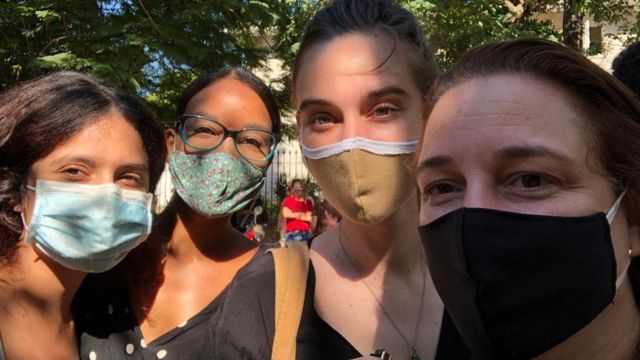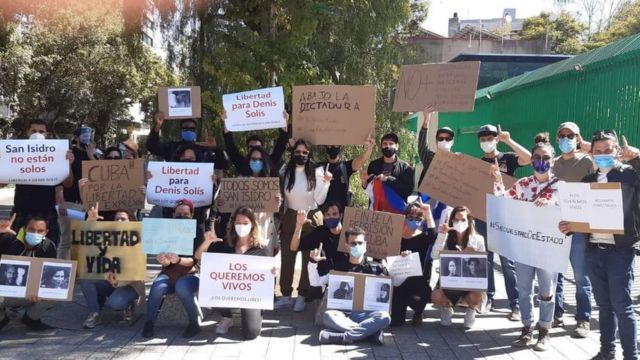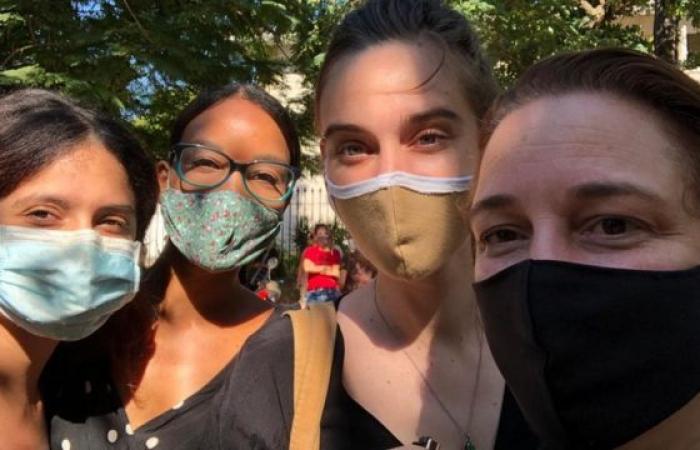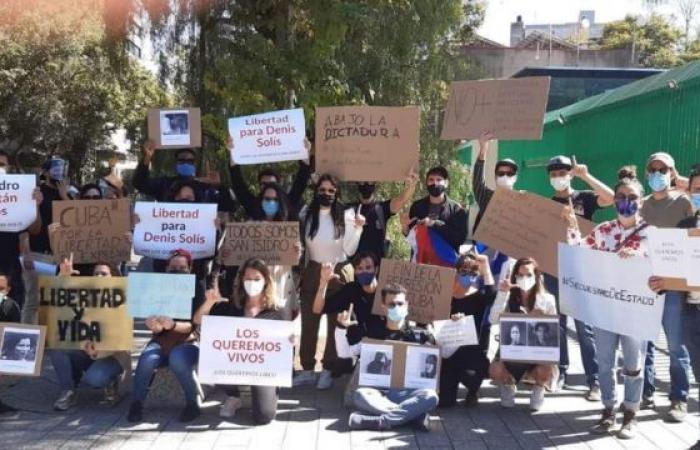- Drafting
- BBC World News
Updated 2 hours
Image source, Camila Acosta
The protesters began to gather from noon on Friday.
More than 200 artists, intellectuals and activists stood in protest this Friday in front of the Cuban Ministry of Culture, a day after the police forcibly evicted a group of young people on hunger strike in Havana.
The protesters mobilized through social networks in solidarity with the members of the so-called San Isidro Movement (MSI), who were expelled from their headquarters and temporarily imprisoned after starting the strike to demand the release of one of its members, rapper Denis Solís.
The official Cuban press considered that Solís had “ties to terrorists” in Florida, calling the hunger strike a “show orchestrated from the US” and assured that the eviction was a security measure to prevent the spread of covid-19.
In a statement published through social networks, the participants in the sit-in – mainly young people – indicated that they were meeting in protest against what they considered “human rights violations” on the island.
“We Cuban artists and intellectuals repudiate, denounce and condemn the inability of government institutions in Cuba to dialogue and recognize dissent, activist autonomy, empowerment of minorities and respect for human and citizen rights,” the text indicates.
“We, in solidarity with our brothers from the San Isidro Movement, demand that justice not be exercised at discretion. Justice cannot protect the Government above the rights of its citizens,” he adds.
Protests of this type are very rare in Cuba, a country with a single party where dissent is systematically repressed and those who oppose the government are labeled “mercenaries” in the service of the United States.
According to several of the participants told BBC Mundo, a power outage occurred during the night, the police surrounded the vicinity of the place and fired tear gas at some people who tried to join the protest.
“They sprayed us with pepper spray to prevent us from reaching the Ministry of Culture. We were dozens of boys. We entered pushing,” said independent journalist Maykel González Vivero.
The MSI, created in 2018, brings together young artists, independent journalists and academics who organized to oppose what they see as repressive measures by the island’s government.
The group has opted for an irreverent and rebellious aesthetic: generating controversy by mixing art and political activism, which has led to numerous clashes with the authorities.
How was the protest on Friday?
Since noon on Friday, dozens of artists, filmmakers, editors, intellectual art critics and young students began to gather in front of the ministry to demand to meet with its head and request support for MSI members.
But what started as a group of just over 20 people turned into over 200 by the end of the afternoon, as participants chanted slogans and songs, clapped their hands or recited poetry.
“It has been a very beautiful and very plural atmosphere. There are people here from all political positions and from all sectors. They are singing, they are rapping, they are playing the guitar. Every 15 minutes they applaud to lift their spirits,” he said. LGBT activist Lidia Romero Moreno tells BBC Mundo.
“As there are musicians and poets, many sing their own songs or declaim their own poetry. There have also been very nice displays of solidarity. As there are many people who have been here since early in the morning, those who arrived later brought them water and snacks, “he adds.

Image source, Tania bruguera
The renowned artist Tania Bruguera (first on the right) was one of the first to reach the Ministry of Culture.
“For several hours they let us pass because the police were stationed in the streets, but we were there until they let us pass,” says Romero.
Initially, renowned personalities such as the artist Tania Bruguera, the filmmaker Mario Coyula and the national prize for Plastic Arts Lázaro Saavedra joined the protest.
Later, at night, other relevant names in Cuban culture such as the film director Fernando Pérez or the actors Jorge Perugorría and Mario Guerra also arrived until they were received at the institution.
“Finally they made a list of 30 people, from different artistic sectors, who were admitted to speak with the Ministry authorities,” says Romero.
In the early hours of Saturday, the people who had entered the Ministry announced that they had reached certain agreements with the authorities, such as starting a cycle of conversations that would include the minister, “meeting without being harassed in independent spaces” and “certainty” that the protesters could return to their homes without being repressed by the police.
“All the points were extremely difficult to negotiate, some were postponed until next week with the minister, others went to independent spaces so that independent artists could also present their visions to the Ministry of Culture,” Bruguera said.
“The Ministry of Culture can no longer say that it does not know the harassment situation that independent art has in Cuba, the persecution and repression that there is against independent art,” he added
What does the protest respond to?
The protest took place after the police broke into the headquarters of the San Isidro Movement on Thursday night and forcibly took members of the group who were on a hunger strike after Solís’ arrest.
The government, for its part, indicated that it was an action by “the Cuban health authorities” with the aim of “certifying the violation of the health protocol for international travelers” due to the covid-19 pandemic, given that one of those present had recently arrived from abroad.
Although most of them were released, two members – Luis Manuel Otero and Anamelys Ramos – were unaccounted for on Friday, which became one of the artists’ claims in front of the Ministry of Culture.

Image source, Camila Acosta
What was initially about 20 people turned into more than 200 in the afternoon.
“We cannot continue to live in a country where there is no security for journalists, activists and those who disagree. Enough of arbitrary arrests, causes created at convenience and whims from power, which today has not been able to respond to the people but to their own survival in power, “they wrote in the statement.
“Today we owe ourselves a different Cuba, where everyone has the same opportunity to participate in the direction the country takes,” they added.
What has the government of Cuba said?
Neither the government nor the official Cuban press immediately referred to the artists’ protest.
However, after the start of the hunger strike by members of the San Isidro Movement, Granma, the official organ of the Communist Party, assured that it was “a new show, implemented from Washington and Miami” and that it was part “of the subversion plans against Cuba “.
For its part, the official Cubadebate portal considered that “the idea that they (the strikers) have is to entertain their contractors by generating social dynamics of civil disobedience and ungovernability, as reflected in the CIA manuals in the so-called ‘non-violent struggle'” .

Image source, Claudia Padron
One of the protests this Friday in front of the Cuban embassy in Mexico.
Regarding the eviction of the MSI headquarters, the state portal Las Razones de Cuba indicated that the operation responded to the fact that one of the journalists who joined the protest who had recently returned from a trip “violated” the country’s security protocols to avoid the spread of the coronavirus.
“Given his refusal to comply with the provisions of the measures decreed by Cuba to prevent the transmission of covid-19 and that apply to people who come from abroad, a complaint was filed at the PNR (police) Station of the town, for the crime of Propagation of Epidemics, which forced an immediate action for the extraction of the people who were in the place “, indicates the note.
The case has generated repercussions in different international media, including the United States The Washington Post, the German DW or the arabic chain Al Jazeera.
Meanwhile, the European Parliament and human rights organizations such as Amnesty International and Human Rights Watch called on the Cuban authorities to release Solís.
The governments of several countries, including the Netherlands, the Czech Republic and the United States, also spoke out against the repression of the group on Thursday night.

Now you can receive notifications from BBC Mundo. Download the new version of our app and activate them so you don’t miss our best content.
These were the details of the news San Isidro Movement: the unusual protest of Cuban artists after the government evicted young people on hunger strike for this day. We hope that we have succeeded by giving you the full details and information. To follow all our news, you can subscribe to the alerts system or to one of our different systems to provide you with all that is new.
It is also worth noting that the original news has been published and is available at en24news and the editorial team at AlKhaleej Today has confirmed it and it has been modified, and it may have been completely transferred or quoted from it and you can read and follow this news from its main source.





